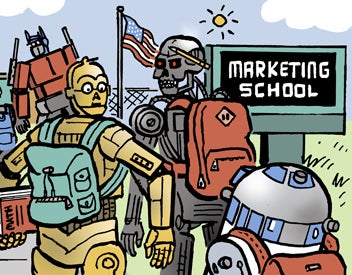When I was a young guy, I would sit at the feet of the direct marketing masters, drinking in their wisdom. Vic Schwab and John Caples were among the first generation, but I was lucky enough to have access to the second generation of masters
Theoretically Speaking
When I was a young guy, I would sit at the feet of the direct marketing masters, drinking in their wisdom. Vic Schwab and John Caples were among the first generation, but I was lucky enough to have access to the second generation of masters — Chris Stagg and Dick Benson and Bob Stone and others. And there was, indeed, a lot of wisdom, only a fraction of which I might have absorbed.
The one question they couldn’t answer, though, was “Why?”
“Why does long copy work better than short copy?” (It doesn’t. In fact, this is one of those direct mail myths that a little theory destroys in a hurry.) The usual reply: “I don’t know, it just does.”
“Why do tactile devices improve response?” (They do, actually.) I’d be told, “Who knows? They just work, that’s all.”
Direct marketing’s pragmatism is most appealing. You know what you’re spending and what you’re making. No hiding behind recall studies, “likability,” qualitative market research, or any other of the soft surrogates of general, above-the-line advertising.
But pragmatism has impeded the development of a theoretical structure, as if you have to choose between theory and practice. Theory is vital because it can explain why things happen, rather than merely what happens. If you understand the “why” you can save a fortune in unnecessary testing, just for starters, and have a leg up on your competition, which remains locked into practice and practice only.
By “theory” I don’t mean anything academic. Theory involves probing into things, thinking, analyzing and coming up with constructs that will improve results. These constructs, of course, must be validated in practice, otherwise they’re worthless.
I’ll confine the following discussion to direct mail, but remember that direct mail is only one of the media used in direct marketing. It is for sure the most complicated and difficult of all media, and in some ways the most rewarding, when you get things right.
Let’s go back to the “Long copy works better than short copy” myth, which you still hear mouthed at DM conferences. This was true in the past to some extent because:
-
Customers were more willing to read.
-
Much direct mail practice evolved in marketing publications (think of the pioneering work of Reader’s Digest, or the Time Life gang). Prospects for publications are readers. Therefore they will look at long copy.
-
Until recently direct mail and mail order were the major communication and distribution channels for non-branded products. Length, which suggested substance, served as a surrogate for branding.
None of this is true in the 21st century, with the possible exception of publications marketing — and I’d be careful about long copy even there. There is no theoretical basis at all for long copy nowadays. Yet marketers still test long copy vs. short copy willy-nilly.
That’s another reason theory is important: Testing is expensive.
Back in the old days, direct mail was cheap. Now it costs a fortune. Sound theory — again, validated in practice — allows you to minimize testing, which increases costs due to smaller production runs and greater complexity. A difference between “pragmatism” and sound theory? Test, test, test vs. don’t test if you already have good reasons for knowing what’s going to work best. “Pragmatism” can cost you money and time. Sound theory can save you both.
What about tactile involvement? How do you get beyond the anecdotal data and folk wisdom that tokens, stamps, and other devices improve response? And what if you don’t want to use tokens or stamps? What if they’re inappropriate to what you’re marketing, or what if you can’t afford them? Are you bereft of one of the key direct mail techniques?
Not if you understand why involvement devices work. They improve response for the following reasons:
-
They prolong the time people spend with a direct mail package.
-
They subliminally suggest response, since responding involves the hand filling out a form, dialing a phone number or accessing a Web site.
-
The sense of touch is right-hemisphere, and the big challenge in 21st century direct mail is to translate a left-hemisphere medium into right-hemisphere terms.
Right hemisphere and left hemisphere: That’s the major theoretical issue in direct mail, how to engage the left hemisphere via the right…how to translate a left-hemisphere medium into right-hemisphere terms.
The brain’s right hemisphere is responsible for instantaneous, involuntary assimilation of information. The left hemisphere takes care of slower, more intellectual processes, such as reading. Even in a postliterate society, direct mail at some point has to be read, at least a little bit. After all, direct mail is decisional and behavioral, and you can’t decide how to behave until you understand the offer that’s being made.
So we now understand that tactile involvement relates to time, the suggestion of response, and the right hemisphere. But we’re a serious company, plus we don’t have much money, so we can’t use stamps or tokens. Is this entire methodology closed off to us?
Not at all, if we understand the theoretical dimension. So in lieu of a stamp or a token, we design a brochure whose fold interrupts a headline. We understand a little about Gestalt psychology, as part of our theoretical studies, so we know that people have such a pronounced intolerance for incompleteness that without even knowing what they’re doing, they’ll unfold the brochure. This does everything stamps and tokens do — cheaply, simply and with dignity.
Now if we know a bit about the physiology of left-hemisphere and right-hemisphere perceptions, we’ll know that the left halves of both eyes connect with the right hemisphere. We will therefore use the left panel of the brochure to communicate an important message, preferably iconically.
What’s an icon? In marketing communications terms, it’s a message that’s assimilated instantaneously and involuntarily by the brain’s right hemisphere.
There are four kinds of icons:
- Graphic
Logos, pictures of people.
- Numerical
This is the reason behind the eternal effectiveness of retail pricing. $49.95 makes a better (cheaper) impression on the right hemisphere then $50.
- Verbal
Words such as free, new, now and best.
- Personal
Symbols relating to private interests, such as golf or cats.
The science of creating a direct mail package, in fact, is a process of working from the outside in. You start by making sure the right icons are on the right surfaces. The key surfaces of a direct mail package are:
- Front of outer envelope.
- Back of outer envelope.
- Above salutation of letter.
- First paragraph of letter.
- P.S. of letter.
- Response device.
- Front of brochure.
- Back of brochure.
When I analyze a direct mail package, I first look at it in terms of icons and surfaces, as well as tactile involvement. If there is a paucity of key icons on critical surfaces and a lack of tactile involvement, I know that the package will have underperformed. Only then, by the way, do I read all the words.
I saw the most awful creative work recently, put together by a big Madison Avenue ad agency that of course didn’t know the first thing about direct mail. Shocking, except I’ve been through this kind of thing a thousand times. You notice that we’ve now talked about an entire direct mail package without once mentioning “creativity,” which David Ogilvy once called “that awful word.”
Creativity is vital, let me hasten to add, but creativity without a theoretical grounding is nonsense. Direct mail creativity should be likened to writing a sonnet. You can do plenty within the form, but if you violate the form, it’s no longer a sonnet. It didn’t stop Shakespeare. It shouldn’t stop you, art directors and copywriters of the world!
James R. Rosenfield (jim@jrosenfield.com) is the author of “Reinventing Direct Mail for the 21st Century,” scheduled for publication in 2005.






